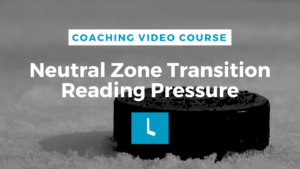In this post we explore a controlled forecheck for a 1-2-2 that’s quite passive. In a game if the other team has stopped and set up behind the net maybe during a line change then we may set up in the neutral zone. This is much more common on a big ice surface but it can certainly happen in the North American game as well.
Controlled Deep Trap:
If the other team is doing some kind of controlled breakout where they’re swinging into corners and coming up as a unit, we may do this deep trap where we have 1-2-2 and we’re essentially waiting for them almost in the neutral zone and we’re going to back up as a group of five players back towards our blue line.
We then try to contain them within the neutral zone holding the red line forcing them to dump it. We’ll get to more of that in the neutral zone forechecking section but it certainly takes place here in this what we call the deep trap because we’re already deep into the neutral zone.
Swing with Speed:
The other version is if the other team is going to swing someone behind the net with speed to pick up the puck. This is quite common using the C, which we would then swing with speed as we would send our F1 to go with them. He/she is less likely to pick up the puck and will end up leaving without it. We can then track back into the middle or our F2/F3 may jump up depending where they move the puck so this one would be called ‘swinging with speed.’
It’s also been done where the F1 sees the the opposing C swinging and can come down lower to almost stand in the path of where that C would be skating. This again prevents this player from wanting to pick up the puck. The rest of the group may move up a little bit in this instance but they’re backing up together so this 1-2-2 forecheck where the first forward is doing a bit of steering or controlled forecheck against a controlled breakup.
This is not as common in the North American style of play, certainly more common on the European ice on the higher levels.
Thanks for reading! Why don’t you take the course and watch the detailed video instead? Will see you in the next video.
(Audio Transcription from How to Play Hockey: Our Minor Hockey Coaching Course.)
Other Minor Hockey Resources
Looking to download half ice hockey practice plans, goalie drills for teams (not a goalie coach?!) or small area games drills? We’ve got you covered too. Click here. Perfect for recreational level coaches.






